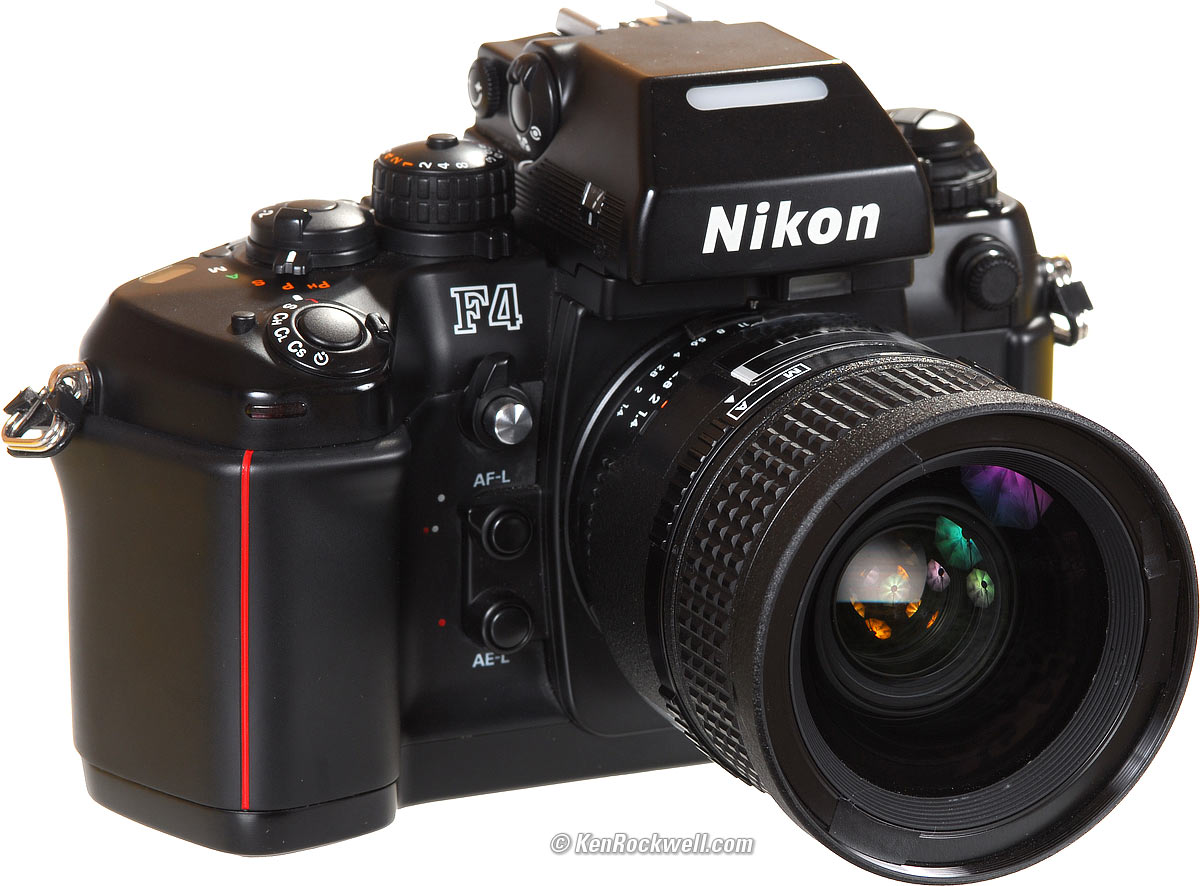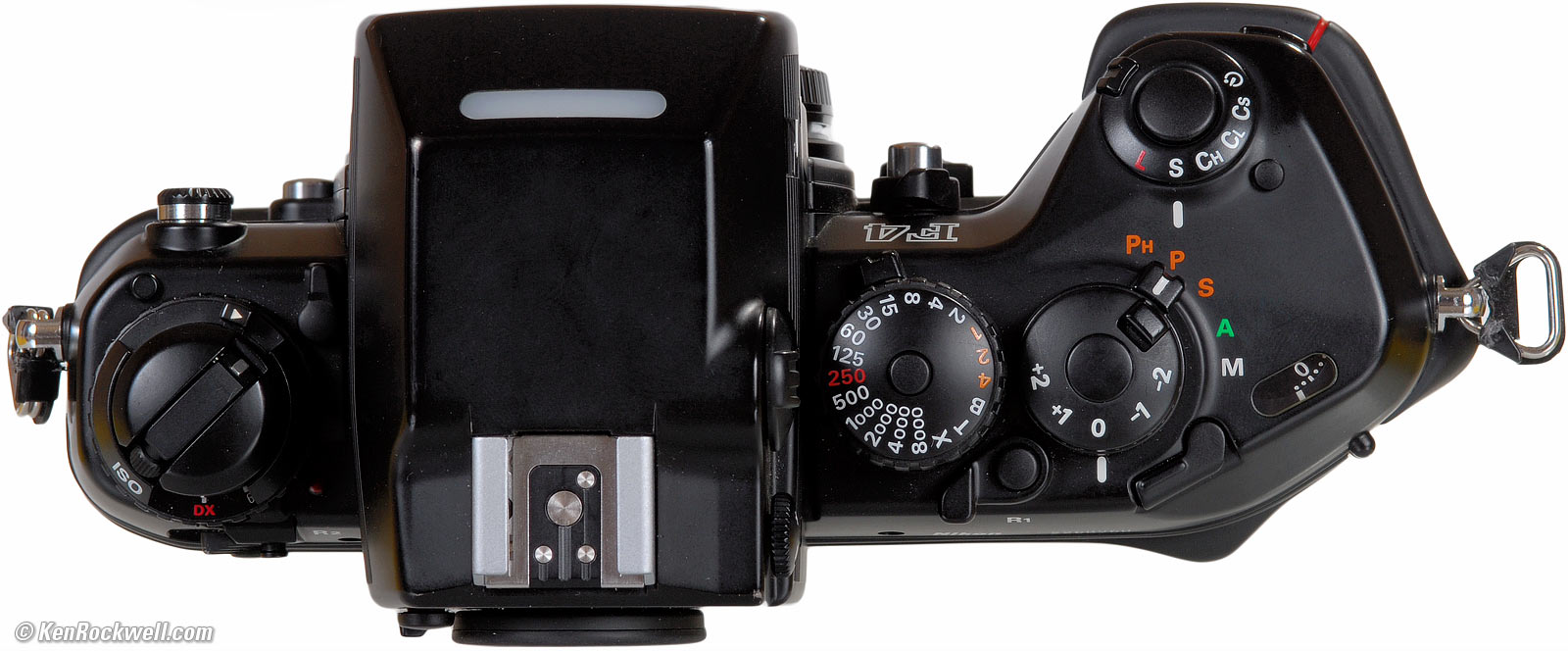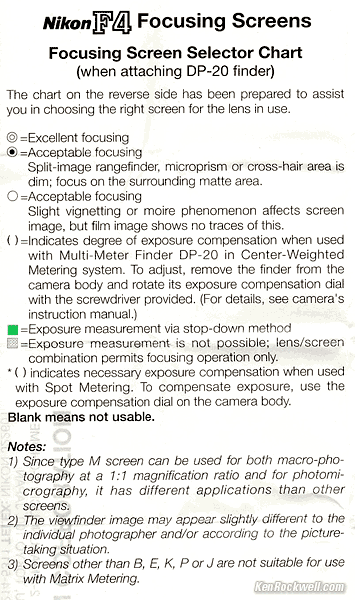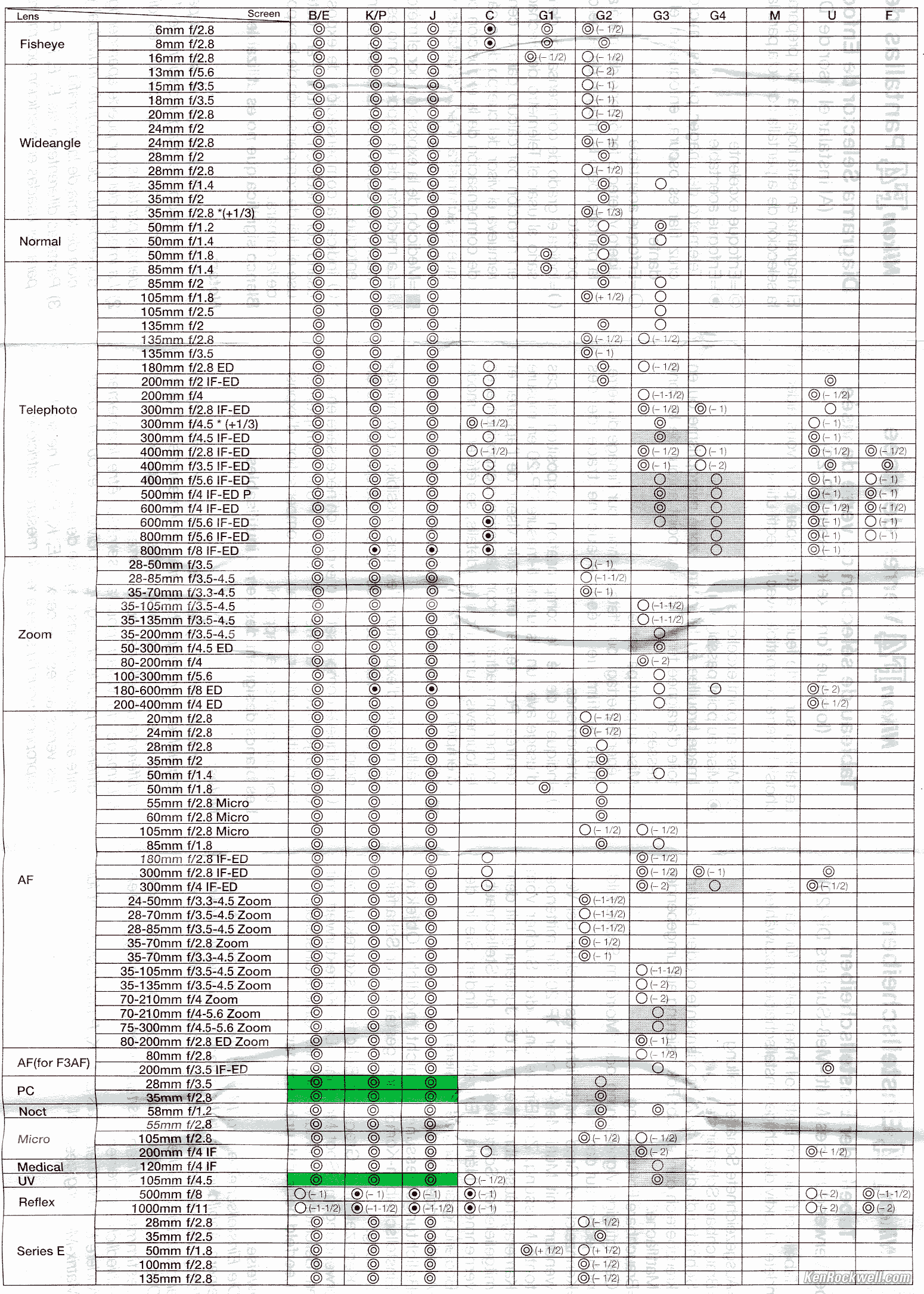Home Donate New Search Gallery How-To Books Links Workshops About Contact
Nikon
F4
(F4, F4s and F4e, 1988-1996)
Nikon F4 (takes 4-AA with MB-20 grip as shown, 42.370 oz./1,201.2 g with alkaline AAs, about $200 used if you know How to Win at eBay, also at Adorama) with 28mm f/1.4D AF. enlarge. My biggest source of support is when you use those or any of these links when you get anything, regardless of the country in which you live. Thanks! Ken.
April 2019 Better Pictures Nikon Reviews Nikon Lenses Nikon Flash All Reviews
Top, Nikon F4. bigger.
Introduction top
|
I buy only from these approved sources. I can't vouch for ads below. |
The indomitable Nikon F4 is the most innovative camera ever introduced by Nikon, or probably anyone. The Nikon F4 is what brought cameras into this modern era.
The F4 shattered more new barriers and advanced more technology in bigger steps than Nikon had ever done before, or has ever done since. Nikon's digital SLRs and F5 and F6 are nice, but still none of them, not even the D3, is as earth-shattering as was the F4 at its introduction.
Nikon's first rangefinders were merely massaged copies of the Contax and Leica.
Nikon's first SLR, the F, was just an SP rangefinder with an added prism. The F was mostly what other companies, like Exacta, had done decades before.
The Nikon F2 was just a reworked F.
The Nikon F3 was an electronic F2, still merely evolution, not revolution.
The Nikon F4, introduced in 1988 and still used daily by many photographers today, was a breakthrough in that:
The F4 is the world's first professional autofocus camera.
The F4 is the world's first professional camera with a built-in motor drive. (Previous cameras had to use klunky external screw-on motors.)
The F4 is the world's first professional camera with modern Matrix (intelligent) light metering.
The F5 was simply the F4 in a tougher package, but with knobs replaced by buttons and menus. The F4 has dedicated knobs for everything. The F5's meter is worse than the F4's when used with manual focus lenses.
The F6 is a lighter-duty F5, but at least one can get Matrix metering with manual focus lenses on the F6, which the F5 can't. You have to program menus to get matrix metering with manual lenses on the F6; all you have to do on the F4 is mount a lens.
The F4 was the world's top news and sports camera from 1988 through the introduction of the evolutionary F5 in 1996. When the F4 was announced, people waited for months to pay over $2,000 for them ($3,600 today after inflation). Today you can pick up a used F4 for just a few hundred dollars!
The Nikon F4 remains relevant today, as it works great with every lens made from 1959 through today's G and AFS lenses. The Nikon F4 is Nikon's most flexible camera because it's compatible with the widest range of lenses of any 35mm camera. Older cameras can't autofocus, and newer cameras don't usually meter well with manual lenses, or work at all with most lenses older than 1977. Canon cameras have no compatibility between auto and manual focus systems: Canon has no compatibility across the 1986 AF-EOS/MF-FD barrier. The F4 does it all with professional élan. The only thing the F4 doesn't do with today's newest lenses is VR. See Nikon Lens Compatibility for details.
Newer cameras may in some ways be better, but no camera has ever advanced photo technology as much as the F4. If I'm shooting 35mm film with modern lenses I grab the F6, but if I need to use things like the 42-year-old 7.5mm fisheye I was loaned along with new lenses, out comes the F4.
The F4 offers full matrix metering automatically with all AI and AI-s manual focus lenses, as well as with al AF, AF-I, AF-S and G lenses. Unlike the FA, the exposure system is open-loop and doesn't correct for any errors in the lens' diaphragm.
The power/drive mode switch never needs to be turned off (L). I leave the F4 set to whatever position, and its batteries are still fine 2 years later.
The F4 was introduced in 1988 and replaced by the F5 in 1996. Read all about the details of the F4 at Nikon's site here.
The F4 is compatible with every lens ever made by Nikon, from the first 1959 non-AI lenses through today's G lenses. It focuses flawlessly with AF-s and G lenses and will work with the ancient fisheyes that recede into the camera body. It gives matrix metering and automation with all lenses made since 1977 (AI and newer). With a few button pushes, it does stop-down metering and automation with non-AI lenses.
The very few things it won't do is that it doesn't activate VR, it doesn't offer Program or Shutter-priority modes with manual lenses. It offers these modes with every AF lens and offers Aperture-preferred and manual modes with manual lenses. It can't do Aperture-preferred or Manual modes with G lenses because G lenses have no aperture ring with which to select the aperture. The F4 does everything directly, not menu-driven aperture selection as newer cameras. With G lenses, I use Program or Shutter-preferred modes.
Except for no VR, these limitations aren't limiting. My F4 is a Swiss Army Knife of functionality and a Rosetta Stone of compatibility.
The F4 makes up for these few shortcomings with separate AE and AF lock buttons put in places where I have enough fingers to use each of them at the same time. More recent cameras put these by the eyepiece where I can't use both separately with one thumb. For my shooting, one AF area and the F4's dedicated AF Lock button are more handy than an F6's 11 AF areas, all never where I want them to be anyway.
The F4 is a wonderful camera, and it's a fantastic camera in 2007 since they are available used for a few hundred dollars. Nikon USA can still do some basic service on them, but they have only limited parts today for repairs.
The F4 feels great in my hands. Its design is beautiful and practical. It doesn't have any menus, pushbuttons or clutter; all entries are made directly with dedicated dials. Even the film speeds and exposure compensations have dedicated dials, which after using newer Nikons, is a very nice change. It looks great as an art object unto itself, devoid of the crappy LCDs on the outside of everything.
The F4 sounds great as it operates. It sounds tight and precise.
The F4 works great. To my surprise, an F4, in 2007, is a joy to use and isn't missing anything significant other than VR. After using it a day, I preferred its dedicated knobs and dials to today's size and cost-reduction inspired multiplexed controls and universal command dials.
For instance, a common thing for me to do is to shoot with fill-flash in dim light. I need to vary the shutter speed to balance the ambient exposure against motion from too long a shutter speed. My digital cameras and an F6 require me to hold and turn two controls to select SLOW sync, then hold some more to select the Shutter-priority mode or set the slowest sync speed in a menu in the Program mode. On an F4, all I have to do is flip the switch to Shutter-priority and flick the shutter speed dial (remember those?) to my choice. As light and motion change, all I do is flick the shutter speed dial; no menus or two-finger commands needed. Oh yes - I can do this all day without taking my eye from the finder of an F4, while newer cameras require stopping everything to look at an external LCD to read sync type.
In 1988 Nikon cautioned that the viewfinder LCD would need to be replaced every several years. I've never seen a bad one, and asking around it's unanimous: decades old LCDs still work perfectly. Nikon was being cautious back in the 1980s, and we lucked out. No one's ever seen a bad viewfinder LCD unless it was abused. My F3 and F4 are still perfect.
The F4's viewfinder is wonderful. It's big, bright, and visible from a long distance. It puts digital cameras to sorry shame, since they are so much smaller. Even better, the viewfinder is uniquely clear among Nikons. Unlike manual focus cameras, it doesn't have the microprisms and split-image devices in the middle of the frame, unless you buy a special screen to do that. Because it only has one AF area, the finder isn't graffitied with the 11 etched AF brackets of an F6. The F4's one AF area isn't made so obvious because it doesn't have to be. The F4's one mild AF bracket doesn't interfere with composition as they do on newer cameras, and it only has one, not 5, 9 or 11. It is much easier to compose on an F4.
The AF area doesn't light up in red at night. You have to know where it is in the dark.
The F4 is two cameras. The F4, introduced in 1988, is a reasonably sized camera taking 4-AA batteries in a hand grip, using the standard MB-20 compact battery holder. The somewhat newer F4S is a beast with a big 6-AA vertical Grip (MB-21). The MB-21 and MB-20 grips are interchangeable, so you can convert either camera as you like. I got a F4S and also got the MB-20 separately, and swapped them to give me the smaller camera. Everything else is the same, except for frame rate and battery life, dictated how much battery power you have on tap.
When I say F4 throughout this review, I usually mean either version.
I first felt one of these in 1988 at my local La Jolla Dean's Camera store who put one in my hand and said "try this." WOW!!!! What a cool camera I thought! It was well above what I could afford and for my landscapes clearly not necessary, since rocks don't move fast enough to warrant autofocus tracking. The AF, the first I had ever tried, was phenomenally fast, and to me quite novel since I'd never tried an AF camera before.
Today the F4 is still an indestructible tank of a professional camera. It was state-of the art in the 1980s but obsolete today technically.
The F100 or even N80 or N55 offer a few more little features, like completely shiftable exposure programs, multiple AF sensors for tracking moving subjects, more up-to date metering, automatic depth-of-field preview that sets itself to the selected aperture even in S and P modes, and except for the N55, VR.
On the other hand, for manual focus lenses the F4 is the only camera on the planet other than the FA and F6 that gives matrix metering. The F4 also has a special movable meter-coupling pin that allows you to use any old Nikkor manual lens, even from the 1950s before automatic indexing!
The F4 also excels in that it has knobs and buttons for everything. It has no menus or LCDs to slow you down. It runs at 5.7FPS and has a quiet mode at 1FPS quieter than other cameras. It has a T ("Time") shutter position which allows you to make time exposures of any length apparently not running down the regular AA batteries, a feature lacking on newer cameras.
The F4 was designed for the future, so it's fully functional with AF-I and AF-S lenses that did not exist when it was released.
Specifications top
Styling and Industrial Design
Giugiaro.
AF
One zone.
Continuous and single modes.
Dedicated, very easy to use and feel AF Lock button.
Power
AA cells.
F4: 4 cells (MB-20 grip, as shown at top, standard in Europe and Japan).
F4s: 6 cells (MB-21, standard in USA).
F4e: 8 cells.
I use alkalines. Throw-away lithium wasn't invented back when the F4s was hot, so Nikon has never researched compatibility, which is why Nikon can't recommend them. Many people use throw-away lithium AAs in both F4 (4 cells) and F4s (6 cells) and they work great.
Weight
F4 and MB-20 small grip: 42.370 oz. (1,201.2 g), measured with 4 alkaline AA cells with strap lugs, but no strap, no lens and no body cap.
Introduction
Nikon introduced the F4 at a world press conference on September 8th, 1988. It addressed rumors about the F4 at its April 12th, 1988 press conference, at which it said that, yes, the F4 was coming later in 1988 and that the F3 would continue to be manufactured, but said nothing more at the April 1988 press conference. As a weird coincidence, also at the April conference Nikon announced that it would introduce its first "still video camera" for photojournalists later in 1988, and did so at the September conference. "Still video" is what we called electronic imaging back then , which of course grew into the digital photography we all know today.
Available new
Production stopped in 1997, and they were available new through summer 2000.
Date Codes
The first F4 started at serial number 2,100,000 in September 1988. Nikon made about 5,000 a month. My serial number starts off as 2,268, which puts it at about June or July 1991.
Focus Screen Selection and Compatibility
The F4 made available many focus screens. All have a 12mm circle as a center-weighted metering guide, a 5mm circle as a guide to the spot meter, and a small rectangle in the middle to delineate the AF area. Screens with manual focus aids in the middle skip the AF area rectangle, and the 5mm circle if it falls inside the manual focus aids.
B Screen: The standard screen of the F4: plain ground glass.
E Screen: Same plain ground glass as the B screen, with a grid.
K Screen: Standard on the F3, adds a central split-image with microprism ring.
P Screen: Same as the F3's K screen, except split-image is at a 45º angle.
J Screen: 5mm central microprism. Standard on older manual-focus cameras.
C Screen: Astro and microscope screen with clear central spot and small crosshairs for aerial image focusing. Surrounded by ground glass, but no fresnel.
G Screens: Clear field (no ground glass, but has fresnel) with big, fat 12mm central microprism. The four versions are optimized for different focal length lenses. None show anything about field; these are for focusing in very dim light.
M Screen: Same as the C "Astro" screen, with millimeter scales running through the center, and adds the usual fresnel absent in the astro C screen.
U Screen: Same as the F4's standard B screen, but with different optics optimized for lenses of 200mm and longer.
F Screen: Same as standard B screen, optimized for long, slow lenses, especially reflex lenses.
Here's how each works with each lens, presuming you're using the standard DP-20 finder:
Performance top
AF (Autofocus)
AF is fast, accurate and consistent. My F4 only has one AF sensor, but that's OK because it also has a dedicated AF-Lock button, making AF easier to use than my newer cameras with a zillion sensors littering my viewfinder but no dedicated AF-Lock button.
My F4's AF seems as fast as the F100, D200 and F6.
The only gotcha for this 1988-era camera is that it isn't as good for tracking moving objects as newer, multi-sensor cameras like the F100 .
I can't seem to get it to track motion well in AF-C (continuous focus) at any of the continuous frame rates Ch, CL or Cs. In AF-C, the shutter cheerfully releases anytime it wants to, regardless of if you're in focus or not. Nikon calls this "release priority" in later cameras, meaning the shutter fires whenever you tell it to. Like most modern Nikons, too, most of your shots in a long sequence will be out of focus.
If you choose AF-S (single focus), the Nikon F4 only fires when it's in focus. In later cameras Nikon calls this "focus priority," meaning it won't fire unless it's in focus. This ensures all shots are in focus, but the F4 isn't trying to track motion in AF-S, either. This means that if the subject is moving and you've chosen AF-S, that your shots will be in focus, but the F4 won't fire very often.
The manual suggests the best way to track motion is to select AF-C and CL advance mode.
See also Autofocus Sports Shooting.
To get shots in focus in a sequence, I'd try shooting in AF-S (single). This way my F4 waits for proper focus before releasing the shutter, regardless of the frame advance setting.
I'm cheap. I rarely shoot sequences on film anymore.
Manual Exposure
The in-finder bar graph is excellent. It's faster and smoother than the same thing in the F6.
Like most Nikons to this day, it bugs me because it seems backwards: minus goes to the right! This comes from the direction in which the aperture and shutter rings rotated on older Nikons that had these controls.
Power
I inserted four new Duracell alkaline AA MN1500 in August 2007. This F4 has sat idle most of the time, and six years later in June 2013 my F4 indicated low batteries, meaning it works perfectly — but the meter only stays on while you have your finger half-pressed ion the button. When removed, the old cells read 60% on the ZTS MBT-1battery tester.
More Information top
I got an F4 to review in August 2007. This page will grow as I get to using the F4 (and F4s) and write about it. For now, expect a lot of loose data floating around the page. Thanks! Ken.
For a fraction the price of today's crappiest Nikon Digital SLR, I got a timeless and enduring masterpiece: The Nikon F4s.
I actually got an F4s, with the big battery pack, and got a smaller MB-20 battery pack to bring it down to carrying size as you see above. Without the big battery, it's simply called the F4; with the big pack, its called the F4s. You can make either camera by swapping battery packs. I also hear there is a humongous battery pack, with which this would be an F4e, for hErnia.
translucent Nikon F4 body cap.
No dry firing: the ALERT light just sits there blinking with no film with the film speed set at its default of DX. No AF either; must open back for AF. For dry firing, set the film speed manually to something other than DX, but be sure to reset it to DX when shooting (unless of course you prefer a deliberate setting different than the film's rating.)
NO AF Assist light
No A mode with G lenses, otherwise AOK
32s max in A and P modes (4s in M and S)
In A mode, display reads to 10s at ISO 100, wide open (20s ISO 50)
Bottom readout requires careful eye position
DOF preview only works in A and M modes. It always stops down to the aperture set on the lens, it's not smart as it is on newer cameras. In P and S modes, since the lens is set at its minimum aperture, the preview button stops down all the way, not to the camera's automatically chosen aperture. I miss this feature in P mode, I wish the F4 did it.
Cs mode sounds like a slow quiet stuttering, not a smooth purr.
Viewfinder LCD reads in half stops, fixed.
The SB-600 works great and communicates with the F4 perfectly. Flash exposure compensation is set on the flash, not the F4. The F4's in-finder exposure compensation warning light turns on when this is set on the flash. The SB-600 wakes up from sleep when the F4 shutter is tapped to turn the meter back on, and of course the in-finder flash ready light works perfectly.
It doesn't work with the SB-400, nor does the SB-400 work on any of the film SLRs except the F6.
The F4's manual intrigues cheapskates like me since it says it uses a "minimum length leader" to ensure at least 36 exposures and possibly more. Nikon's a tease: I get 37 shots on a roll, the same as other cameras.
© Ken Rockwell. All rights reserved. Tous droits réservés. Alle Rechte vorbehalten.
Help Me Help You
I support my growing family through this website, as crazy as it might seem.
The biggest help is when you use any of these links when you get anything. It costs you nothing, and is this site's, and thus my family's, biggest source of support. These places always have the best prices and service, which is why I've used them since before this website existed. I recommend them all personally.
If you find this page as helpful as a book you might have had to buy or a workshop you may have had to take, feel free to help me continue helping everyone.
If you've gotten your gear through one of my links or helped otherwise, you're family. It's great people like you who allow me to keep adding to this site full-time. Thanks!
If you haven't helped yet, please do, and consider helping me with a gift of $5.00.
As this page is copyrighted and formally registered, it is unlawful to make copies, especially in the form of printouts for personal use. If you wish to make a printout for personal use, you are granted one-time permission only if you PayPal me $5.00 per printout or part thereof. Thank you!
Thanks for reading!
Mr. & Mrs. Ken Rockwell, Ryan and Katie.








